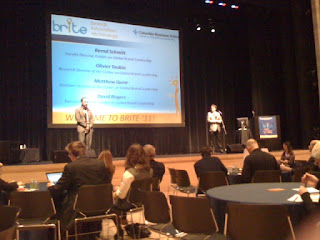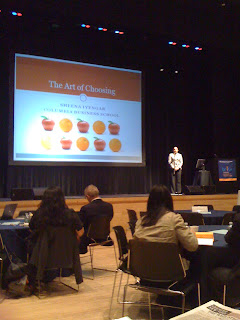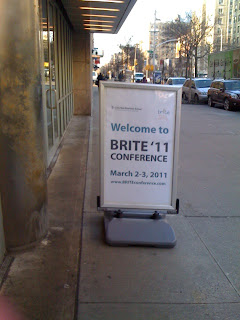Here are my BRITE Conference highlights.
Large corporations are internalizing social principles and marketing differently.
VISA - Antonio Lucio, global chief marketing officer described how, over a two year period, coinciding with the company going public, the company transformed itself to think audience first, guided by social media principles of sharing, participation and recommendation, activated via a combination of paid, owned and shared media.Antonio discussed the new path to customer transactions, from funnel to loyalty loop across many touch points, with an army of advocates.
He described the social media principles as:
- Sharing is the new giving.
- Participation is the new consumption.
- Recommendation is the new advertising.
 |
| David Rogers, Schmitt open BRITE Conference '11 |
1. Aired an honest ad: "We listened to our toughest critics; they inspired us to reinvent our pizza from the crust up." Added live Twitter feed to home page; included long form video to further detail the story. Note: used documentary style film maker.
2. Ad based on having focus group participants try the new pizza. Posted the entire video online so viewers could see for themselves that the footage was authentic.
3. Found consumers who had never tried Domino's. Held an online competition to identify Domino's Pizza holdouts [e.g., Scott Schoyer].
4. Show us your pizza invited customers to upload their own photos of Domino's Pizza. This was in contrast to normal product photo practice which had little to do with fresh pizza.
5. Show us your problems. Send photos of poor looking pizza or delivery issues.
6. Where do the ingredients come from? Focus on 100% transparency let to BehindThePizza.com
Critical learnings:
- Listen and do something about what you learn.
- Very important to report back to detractors on changes made. Show response.
- There's nothing to hide.
FedEx - Renee Horne, director digital and social media engagement, explained how, as FedEx has shifted investments from traditional paid media to owned and earned media sources, it has embraced social media most visibly via the IamFedex.com program whereby Fedex employees tell their story.
FedEx has noticed how customers are engaging through social networks and are much more likely to trust conversations taking place on earned sources [i.e., on social platforms]. This is a critical point!
In the 1980s, FedEx relied on broadcast networks to communicate in a linear model. That model has become irrelevant. The new model is about dialog with customers. The role of the marketer has evolved, as has that of company employees. Employees are now brand ambassadors who generate creative ideas [i.e., content] for reaching out to and engaging with customers. Hence, IamFedex.com where 275k FedEx employees from around the world, in a multitude of languages, celebrate their personal stories.
 |
| The VISA loyalty loop |
Power of Purpose in a transparent world [aka radical transparency]
Tim Maleeny from Ogilvy described the Big IdeaL, for brands with a higher purpose focused not on transient share-of-mind ideas, but rather share-of-culture ideals.I loved the contrast Tim made between short term brand campaigns that are advertising focused, front loaded with recurring costs
and
long-term, business focused ongoing behaviors that are cost efficient, redefine the category, drive employee loyalty and epitomize a brand's best self and the existing cultural tension. Examples: Dove addressing that only 2% of women think themselves beautiful, IBM wanting to build a smarter planet, and Coke focusing on bottled happiness. [See Dove - What is Real Beauty?]
Hank Cardello, author of Stuffed: An Insider's Look at Who's (Really) Making America Fat
Carol Cone from Edelman Citizenship shared intense passion for "the power of purpose in a transparent world" and the need for Capitalism to have a human face given the all time low recent Trust Barometer results. 86% of consumers say that business must align performance with social concerns; 62% will switch if a company doesn't. Many corporations are changing their mission to include performance with a purpose.
Having a purpose benefits businesses. It creates a difference; leads to innovation, growth and sales; it builds and protects reputation and it engages customers and employees. Purpose fuels growth and it evolves. To be authentic, though, it's important to pick the issue first, identify credible best partners and then consistently support the issue.
Intense Innovation
Robert Russell, director of mobile marketing solutions with AT&T, described how mobile has passed TV and traditional media on many usability metrics. The smartphone is the equivalent of 1:1 marketing. But, mobile doesn't exist in isolation. It requires related assets - from signage, to web, TV, WiFi and direct mail. The mobile marketing ecosystem includes:- Media: online, billboards, direct mail, point of sale, digital signage, print
- Mechanism: QR code, RFID, location based services, 800#
- Platform: mobile application platform, code management, cloud computing
- Result: information, video, games, coupons
Location based messaging: SMS combined with location becomes more relevant to customers. Imagine having a geofence around stores and, if you've opted in, you can receive relevant messages from retailers when you cross the fence.
Here's a recent article you'll find relevant: Coming Soon: Advertiser alerts on your phone
Luke Williams, author of Disrupt: Think the Unthinkable to Spark Transformation in Your Business
Luke described 2004 research by Richard Nisbitt about how culture affects our thinking. He analysed what students from the West and Asia paid attention to when looking at the same images. The Westerners looked at the foreground whereas the Asians focused on the environment/context. Conclusion: Westerners were change blind suggesting a type of myopia when focused on brand-building and technology [e.g., think Apple].
The need for disruptive innovation becomes critical when brands focus on giving consumers what they expect plus more. At some point - have you tried to simply pick out a tube of toothpaste lately? what do all of those options mean? - nothing stands out for customers. Disruptive innovation isn't about technology; that is myopic. Better to focus instead on behavior revolution [e.g., the Internet aka MP3 generation has a different frame of reference and values for speed, convenience and quality].
Changes in consumer behavior trigger a need for new brand thinking. Look at brand conventions and mix them all up. Break free. See the new. Be unpredictable.
 |
| Fedex's marketing evolution |
Steve Rubel, senior vice president, director of insights, Edelman Digital, presented the Eleven Digital Trends to Watch in 2011. I'll cover those in a separate post.
Sheryl Roth Rogers, chief marketing officer of Mom Central Consulting, in a discussion about social commerce, focused on the art of influence and activating moms on behalf of brands. Brands building relations with customers represents a paradigm shift.
Traditional brand building focuses on ROI, targeted impressions and CPM which Sheryl equated to counting frogs and raindrops in the rainforest. Social media marketing focuses on spheres of influence and many small circles of influence coming together, people talking to each other and becoming passionate enthusiasts. Brands need to understand the tapestry of brand engagement associated with social media and social commerce.
Professor Leonard Lee moderated the social commerce discussion which also included Bill Chasen from Stickybits, allowing you to attach digital content to any object using bar codes that can be read using the Stickybits app, and Marissa Evans from GoTryItOn.com, a social retailing website with 100k iPhone users [80% women, 40% global] who upload photos of themselves wearing outfits to get opinions on whether to wear the outfit or not. He made the following observations:
- Social commerce is here to stay.
- If done properly, it's effective to sell with a social approach.
- It's critical to be customer focused particularly in executing the product experience.
- It's an iterative process.
- It's important to integrate across all customer touch points.
- Meet consumers' needs
- Tailor the experience into snack bites depending on how customers consume information.
- Be ready for increased levels of transparency.
He sees his role within Citi as trying to be disruptive in reminding people about the customer perspective. The customer controls the message; we all read reviews written by other customers before buying. Bad conversations happen; it's better to know about them so you can do something about them.
Customer service is the new PR and the new marketing. It's about person to person interaction with customers.
Josh Millrod/Jason Clement from Weiden + Kennedy [whose mission is "to create strong and provocative relationships between good companies"] described how to socialize brands and activate digital communities. Mind you, they are behind Old Spice and Isaiah Mustafa.
Socializing is the antithesis of traditional advertisting: "you can't socialize with 1 million people at once."
Furthermore, "scale isn't always achieved by creating something that appeals to the largest number of people" [I find this concept fascinating].
Examples include Wheat Thins pallet, Lufthansa Beer Garden and Lil B "cooking dance". Old Spice represents a traditional advertising concept. The challenge was figuring out how to make it more social. Solution: have Mustafa respond to individuals!
On finding ways to scale 1:1 conversations:
- Don't rely on an army of interns.
- Appeal to the masses by creating for a few.
- Inspire others to host the conversation for the brand.
- This requires that you find what the truth is about your brand.
 |
| Iyengar: The Art of Choosing |
[See Sheena Iyengar & the Power of Choice which includes a video.]
Three negative consequences come from too many choices: commitment [it's easier to delay choices], make worse choices [the decision quality decreases] and satisfaction diminishes.
"Our eyes are too big for our mind" as well as our stomach.
The ideal number of choices that our perception and memory can handle: magical #7 +/- 2 [Note: experts can handle more choices in their area of expertise.]
When are we better off when we have more choices? It depends on the level of experience in the choosing domains. A chess master thinks 8 moves ahead and considers an infinite number of options. However, s/he sees the chess board as patterns and can therefore zero in on the best, most relevant options.
Today's marketplace is designed for experts, but we aren't all experts. Here are three techniques to improving the choosing experience:
1. Cut: careful trimming can increase sales and improve profitability. It eliminates redundant options.
2. Categorize. Experts do this; very helpful for novices. Best Cellars does this effectively for wine, grouping them into 8 categories, with more information within each category. Be useful to the chooser, not the creator of the category.
3. Condition for Complexity. Need a methodical approach to having lots of choices. If you start with deep to shallow options, customers are less likely to engage; you lose them. However, if you start with shallow questions and proceed to more involved options, customers are more likely to hang in and satisfaction with their choice increases.
[Culture does play a role in choice because criteria are a function of culture.]
Talk about a lot of valuable insights!
Be sure to check out Brad Jobling's BRITE Conference 2011 Highlights.
Also, Randall Ringer has a fabulous series of posts detailing BRITE 2011:
- It will be BRITE later
- BRITE early
- Too BRITE – or – back to the office I go!
- When We Were BRITE And Young…
On the social side, I had the opportunity to meet for the first time in person Frank Eliason, BL Ochman and Denise Lee Yohn and get caught up with David Polinchock, Brad Jobling, Tom Guarriello [you might enjoy Tom Guarriello On Bridging New & Old: Social Media Series] and Anne Mai Bertelsen.
Did you attend or follow BRITE Conference? What were your highlights?
Added 3/16/11: Denise Lee Yohn's Top Tweets From BRITE Conference 0311









No comments:
Post a Comment
Reminder: Please, no self-promotional or SPAM comments. Don't bother if you're simply trying to build inauthentic link juice. Finally, don't be anonymous: it's too hard to have a conversation. Thanks, CB